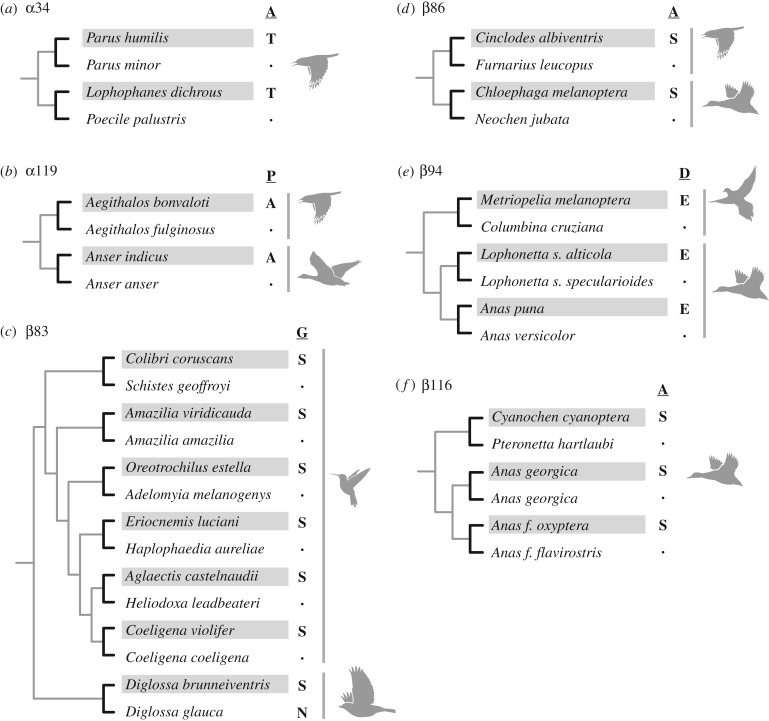Figure 3.
Phylogenetically replicated substitutions that contributed to derived increases in Hb–O2 affinity in different lineages of high-altitude birds. The select pairs of high- and low-altitude taxa are taken from the set of 70 taxa shown in figure 1. In each case, the high-altitude taxon is denoted by shading and the inferred ancestral amino acid is shown as the reference state. (a) Parallel substitutions at α34 in two high-altitude passerines from the Sino-Himalayan region. Paired comparisons between high- and low-altitude taxa involved ground tit, Parus humilis (high) versus oriental tit, P. minor (low), and grey-crested tit, Lophophanes dichrous (high) versus marsh tit, Poecile palustris (low) [26]. (b) Parallel substitutions at α119 in high-altitude passerine and waterfowl species from the Sino-Himalayan region. Comparisons involved black-browed bushtit, Aegithalos bonvaloti (high) versus sooty bushtit, A. fulginosus (low), and bar-headed goose, Anser indicus (high) versus greylag goose, A. anser (low) [26,35,36]. (c) Parallel and convergent substitutions at β83 in high-altitude hummingbird and passerine species from the Andes. Comparisons involved sparkling violetear, Colibri coruscans (high) versus wedge-billed hummingbird, Schistes geoffroyi (low), green-and-white hummingbird, Amazilia viridicauda (high) versus amazilia hummingbird, A. amazilia (low), Andean hillstar, Oreotrochilus estella (high) versus speckled hummingbird, Adelomyia melanogenys (low), sapphire-vented puffleg, Eriocnemis luciani (high) versus greenish puffleg, Haplophaedia aurelieae (low), white-tufted sunbeam, Aglaeactis castelnaudii (high) versus violet-fronted brilliant, Heliodoxa leadbeateri (low), violet-throated starfrontlet, Coeligena violifer (high) versus bronzy inca, C. coeligena (low), and black-throated flowerpiercer, Diglossa brunneiventris (high) versus deep-blue flowerpiercer, D. glauca (low) [27,29]. Note that the inferred ancestral state for β83 of hummingbirds is glycine (G), but the inferred ancestral state for this same site in Diglossa is asparagine (N). Thus, the βN83S substitution in D. brunneiventris represents a convergent substitution relative to the hummingbird clade. (d) Parallel βA86S substitutions in high-altitude suboscine passerines and waterfowl species from the Andes. Comparisons involved cream-winged cinclodes, Cinclodes albiventris (high) versus pale-legged hornero, Furnarius leucopus (low), and Andean goose, Chloephaga melanoptera (high) versus Orinoco goose, Neochen jubata (low) [28,29]. (e) Parallel βD94E substitutions in high-altitude doves and waterfowl species from the Andes. Comparisons involved black-winged ground dove, Metriopelia melanoptera versus croaking ground dove, Columbina cruziana, Andean crested duck, Lophonetta specularioides alticola (high) versus Patagonian crested duck, L. s. specularioides (low), and Puna teal, Anas puna (high) versus silver teal, A. versicolor (low) [28,29]. (f) Replicated βA116S substitutions in high-altitude waterfowl. Comparisons involve Abyssinian blue-winged goose, Cyanochen cyanoptera (high) versus Hartlaub's duck, Pteronetta hartlaubi (low) and high- versus low-altitude subspecies of yellow-billed pintail, Anas georgica, and sharp-winged teal, A. flavirostris. In the latter two taxon pairs, the derived Ser-β116 variants do not have independent mutational origins in the two highland taxa; the allele-sharing is attributable to a history of introgressive hybridization [28].

